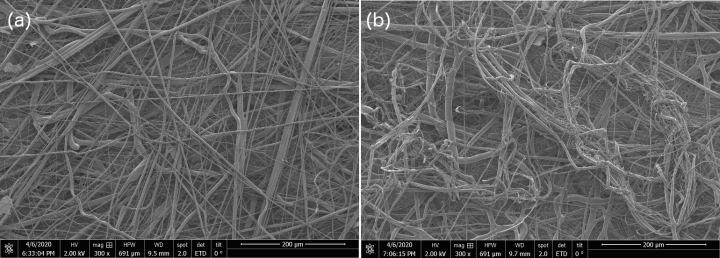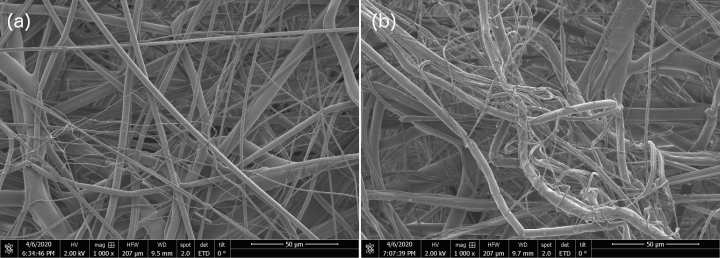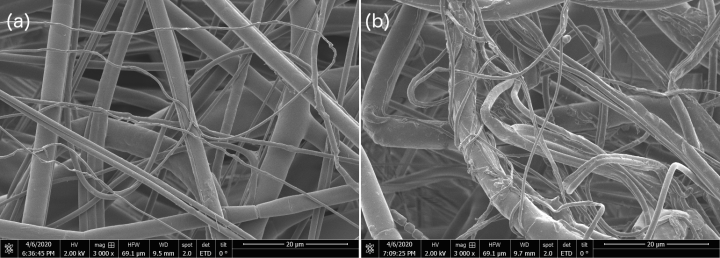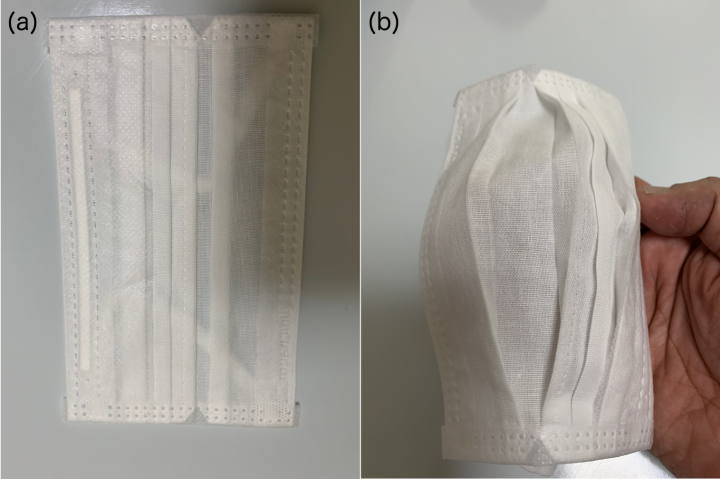The content on this webpage is now out of date. Further work was undertaken after this webpage was created. The full details of this work can now be accessed from the published manuscript at: M. M. Bandi, "Electrocharged facepiece respirator fabrics using common materials", Proc. Roy. Soc. A. 476, 20200469 (2020).
N95-electrocharged filtration principle based face mask design using common materials
著者:マヘッシュ・バンディ、沖縄科学技術大学院大学(OIST)非線形非平衡物理学ユニット
本ページはオープンアクセス情報であり、だれでも自由に利用できます。
日本語版は試訳であり、英語版を原本とします。
目次
- N95フィルター原理
- 帯電フィルター
- 綿菓子製造機でエレクトロスパンポリマーファブリックを製造
- 改造した綿菓子製造機
- 自家製の帯電ポリマー生地の基本的な特性
- 綿菓子製造機で作る帯電ポリマー材料に基づくマスク設計
- 最終的な詳細:重要
- 謝辞
進行中のCOVID-19パンデミックにより、ウイルスからの保護用のフェイスマスクの使用が必要になっています。現在、多くの国では、個々人に公共の場所でのフェイスマスクの着用を義務付けています。しかし、フェイスマスクが店頭から姿を消し、手作りの布マスクが必要になっています。一方、自家製の布製マスクもほとんどの市販のマスクもCOVID-19ウイルス粒子をフィルターできません。COVID-19ウイルス粒子を阻止できる唯一の利用可能な設計となっているのがN95マスクです。これは、数百ナノメートルレベルでエアロゾル液滴、ウイルス粒子、およびバクテリアを誘引・トラップできる帯電層が含まれているためです。残念ながら、この帯電ポリマー層は、一般的に入手可能な材料を使用して複製するのは多少難しい(不可能ではない)工業的に洗練されたエレクトロスピニング法によって製造されています。
このページでは、OIST学内で開発した、一般に入手可能な部品を使用してこの帯電層を製造するプロセスと、フェイスマスクを構築するための基本的電気回路の知識について詳しく説明しています。
私たちのテスト(詳細は以下)は、フェイスマスクのデザインが自家製の布製マスク、市販のPM2.5フィルターマスク、サージカルマスクよりも優れていることを示していますが、以下に説明するいくつかの理由により、N95マスクのレベルまでの機能には達していません。このフェイスマスクのデザインは、NIOSHなどの関連機関によるテストや認定を受けていません。またこのマスクデザインは、現状のまま保証なしで提供するものとなります。
N95フィルター原理
フェイスマスクフィルターメカニズムは、2つの競合する要件において、最適化する必要があります。マスクフィルターは、粒子をトラップするのに十分な小さい細孔サイズである必要がありますが、細孔サイズが小さすぎると装着者の呼吸も妨げられるため、マスクフィルターは特定の平均細孔径を下回ることはできません。この最適化要件を満たすために、N95マスクは基本的に3つの原則で作用します(下の図1を参照)。
1)慣性衝突:エアロゾルまたはダスト粒子は通常、1ミクロン以上のサイズで十分な慣性があり、フィルター層の繊維の周囲を流れ、マスク材料に衝突してブロックされます。
2)拡散:慣性の影響を受けない1ミクロン未満、通常0.1ミクロン以下の粒子は拡散し、フィルター繊維の曲がりくねった多孔質マトリックスの周囲をブラウン運動する間にフィルターの繊維層に付着します。
3)静電引力:このメカニズムは、帯電したポリマーまたは樹脂繊維を使用して、大小の反対に帯電した粒子を引き付け、トラップします。
図1:N95マスクが利用する3つの原則の図。(a)2006年の全米アカデミーズ出版報告では、3つの段階を詳述しています(図のクレジット:Institute of Medicine 2006. インフルエンザパンデミック時のフェイスマスクの再利用可能性:対インフルエンザ ワシントンDC:全米アカデミープレス。https ://doi.org/10.17226/11637。)(b)CDCウェブページには4つの原則が記載されていますが、慣性衝突原理の中でCDCによってリストされた遮断原理を含みます(画像提供:CDCウェブページ https://blogs.cdc.gov/niosh-science-blog/2009/10/14/n95).
布や市販のフェイスマスクは、手間をほとんどかけずに第1と第2の原則を達成できます。第3原則である静電吸引は、N95マスクを他のフェイスマスクと区別するいくつかの設計機能の1つです。帯電したフィルター層の作製は簡単ではありません。
帯電フィルター
私たちは、特に周囲の湿度が低い寒冷気候での一般的な経験から、2つの布を互いに摩擦させると静電気を帯びることを知っています。これは一般に摩擦帯電と呼ばれる現象です。ウールや綿などの粗さの高い天然繊維から織られた布や、ナイロンなどの合成布でさえ、摩擦により静電気を帯びます。帯電した繊維を利用してフィルター機能を助けるという考えは、数十年前にさかのぼります(たとえば、Edward R. Frederick(1974)による簡単なレビューを参照してください)繊維フィルターにおける静電気の影響、Journal of Air Pollution Control Association、23、1164。 DOI:10.1080 / 00022470.1974.10470030)。実際に、帯電フィルターを組み込んだいくつかの初期のフェイスマスクの設計では、ウール繊維またはフェルト繊維を使用していました。しかし次第に、エレクトロスピニング法で製作されたポリマーファブリックは、フェイスマスクデザインの帯電層の主力材料になりました。
エレクトロスピニングされたポリマー材料は、エレクトロスピニング(電界紡糸)と呼ばれる方法で製造されます。これは、ポリマーナノファイバーを生成するために広く使用されているプラットフォームです。この方法では、高粘度の溶融ポリマーが小さなオリフィス(開口部)から押し出されます。溶融ポリマーを保持するオリフィス(開口部)を備えた金属製の容器(これをエミッターと呼びます)は正に帯電し、離れて配置された平板またはドラムは負に帯電します(これをコレクターと呼びます)。溶融ポリマーがエミッターのオリフィスから押し出されると、正に帯電した溶融ポリマーが飛び出し、負に帯電したコレクターに向かって引き寄せられ、エミッターとコレクターの間の距離において急速に冷却され、電気的に帯電したポリマーナノファイバーになります。この産業用エレクトロスピニング法は、通常、日常的には使われません。
研究室の環境と産業用の環境の両方で電界紡糸法を説明する多くのYouTubeビデオがあります。ここには、皆さんの理解を助けるいくつかの動画を紹介しています。これらはYouTubeで最初にヒットしたもので、これらのリンクを他のリンクよりも優先して選択した特定の理由はありません。
注:工業用または学術用のラボのエレクトロスピニング法を我々が保証するものではありません。
https://www.youtube.com/watch?v=hlHUVJkDuNo
https://www.youtube.com/watch?v=Dn6r1Ag1npE
https://www.youtube.com/watch?v=x0VFeMTSIb4
https://www.youtube.com/watch?v=PJWMtdaYxi8
https://www.youtube.com/watch?v=6hRv7m1MOC0
https://www.youtube.com/watch?v=OIUSSUWhXhM
溶融ポリマーのエレクトロスピニングの原理を以下の図2に示します。
綿菓子製造機でエレクトロスパンポリマーファブリックを製造
一般的に入手可能な部品を使用してエレクトロスパンポリマー・ファブリックを生成する簡単な方法は、綿菓子製造機を少し改造することです。私たちは皆、綿菓子製造機が動作する基本原理を知っています。
1)ドラムがあり、その中央には砂糖3と水1を入れる高速回転容器が置かれています。私たちがEMITTERと呼ぶこの容器は、砂糖を粘稠な液体にカラメル化するために、摂氏約160〜175度に加熱されます。
2)高速回転容器には小さな穴があり、そこから粘性のあるキャラメル化した砂糖が流れ出し、遠心力によって粘性のある砂糖の滴が砂糖の細いナノ結晶繊維に引き伸ばされ、棒で綿菓子の形に集めます。
3)では、これに少し変更を加えまましょう。電圧源を使用して高電圧電界(12〜24ボルトの範囲で作業)をセットアップするとします(下の図3を参照してください)。
4)マスクの繊維を作製するためには、砂糖の代わりに、粉末状のポリプロピレンポリマーを注ぎます。ポリプロピレンのプラスチックボトルを細かく切り、高出力ブレンダーに入れて、粉末状のポリプロピレンを作製した後、毎分数千回の回転をさせれば、エレクトロスピニング(電界紡糸)されたポリマーの生成が開始されます。そしてコレクターの表面に帯電したナノファイバーで構成される繊維を収集できるのです。
注:摂氏160度でのポリプロピレン(または他のプラスチック材料)の溶融および噴出プロセスは、ほとんどの生物学的材料(特に細菌、真菌、ウイルス)を不活性化する可能性があります。ただし、オートクレーブでは通常、同等の温度(摂氏160〜190度)で15〜120分のドライサイクルで運転されます。互換性のある材料の場合、滅菌は通常摂氏120度でしかも、かなり高い圧力(100 kPaなど)のウェットサイクルで行われます。蒸気は細胞を開いて破壊し、タンパク質と核酸を不可逆的に変性させるのに役立ちます。ところが、ブレンダーを通過した汚染されたボトルのポリマー粉末を急速に溶融しても、潜在的な汚染物質の感染性が100%破壊されることはなく、結果として得られる材料を顔の保護に使用する場合は、特に懸念されます。そのため、プラスチックを圧力鍋に入れて20分程度強蒸気にさらしてからフードプロセッサーに入れて粉末状にすることをお勧めします。
5)私たちは単純な理由からポリプロピレンを使用しました。市販されている標準的な綿菓子製造機の加熱温度は160〜175度です。ポリプロピレンの融点は160℃です。したがって、綿菓子製造機は発熱装置の部分を変更する必要がありません。また、ポリスチレンやポリエチレンなどの他のプラスチック長鎖高分子材料(PETボトルなど)も自由に使用できます。融点や印加電界などのパラメータのいくつかは、使用する材料によって確かに異なりますが、試行錯誤によって容易に理解できるものであり、ロケット科学とは異なり簡単です。
6)さらに簡単な方法としては、ポリプロピレンを有機溶媒(アセトンなど)に溶解することが考えられますが、アセトンは一般的に入手できる材料ではないと考えました。
7)さらに、綿菓子製造機に設置できるプラスチック製のカバーがあったため、それに穴を開け、アルバックの真空ポンプに接続されたパイプを突き刺してチャンバーを真空にしました。さらに、パテやパン生地などを置くことで、カバーと容器を密閉しました。これは単に、回転式ジェットエレクトロスピニングシステムでのエレクトロスピニングプロセス中に、環境を清潔に保ち、粉塵のない状態を保つために行いました。OISTで研究用のエレクトロスピニングシステムによく利用する部品を装備した装置です。ほとんどの人にとって、少なくとも住宅環境において、真空ポンプを使える機会がないことはわかっていますが、もし読者が大学のラボにいる場合、この簡単なアイデアを利用して、エレクトロスピニングを確実に行えます。ポリマーナノファイバーは、セミクリーンルーム条件で製造されます。いずれにしても、真空ポンプは必須ではありませんが、役には立ちます。下の図4の簡単なイラストを参照してください。
7)綿菓子製造機をお持ちでない場合は、一般的に入手可能な最小限の部品を使用して独自のセットアップを行うためのDIYビデオがいくつかあります。ここにいくつかのDIYのyoutubeビデオリンクを紹介します。繰り返しになりますが、YouTubeですぐにヒットするリンクを含めました。他のリンクよりもこれらを選択する特別な理由はありません。繰り返しますが、注意:特定のDIY綿菓子製造方法を推奨するわけではありません。
https://www.youtube.com/watch?v=KN7Ac5Le434
https://www.youtube.com/watch?v=04oBgUyIr8I
https://www.youtube.com/watch?v=qYubkFzl0F8
https://www.youtube.com/watch?v=kk_2O8w1Uec
https://www.youtube.com/watch?v=7KpXkrtwc_Q
https://www.youtube.com/watch?v=s7E28_sJoEI
https://www.youtube.com/watch?v=7Dn47kO2p6E
改造した綿菓子製造機
私たちは幸運にも、プロ用の大きな綿菓子製造機(パラゴンクラシック綿菓子製造機)を見つけることができました:https://www.amazon.com/Paragon-Classic-Floss-Cotton-Machine/dp/B005C9GT5O/ref=sr_1_1?dchild=1&keywords=Paragon+Classic+Floss+Cotton+Candy+Machine&qid=1586409734&sr=8-1 )。高電圧電界源でショートしてしまうこと避けるため、エミッターとコレクターを厚いテフロンディスクで絶縁する必要がありましたが、それ以外は、高電圧接続をできるようにマイナーな変更を加えた後、非常に迅速に作業を開始しました。
注:エレクトロスピニングプロセスは、ポリマーの水滴をエミッターからコレクターに加速させるために高い直流電圧を使用します。綿菓子製造機を改造し行っているこのロータリージェット法は、遠心分離による機械的加速を利用しています。当初我々は、この詳細な、しかし重要な事実に気づいていなかったのですが、使用していた綿菓子製造機がヒートアップし、ポリマーナノファブリックをコレクターのドラムから取り出す前にまた溶かしてしまうことに気づきました。従って、(当初このページに14〜40キロボルトと示していましたが、)直流12〜24ボルトの電圧源でプロセスを行うことができることについて、お詫びして修正し、全体の記述も一部修正しています。
母材にはポリプロピレンパウダーを使用し、従来のシリンジ注入エレクトロスピニングプロセスよりもはるかに高いスループットでエレクトロスピニングポリマーナノファイバーをすばやく入手しました。毎回、数十グラムのポリプロピレン材料を使用し、結果として得られた電界紡糸ポリマーナノファイバー材料は、ドラム(COLLECTOR)の内壁に集まり、それらをハサミで簡単に切断し、2つの厚いガラスプレートの間に挟み、多孔質布シートを作製しました。
自家製の帯電ポリマー生地の基本的な特性
エレクトロスピニング法で製作されたポリマーナノファイバー・ファブリックでいくつかの特性テストをしました。以下詳細:
1)2つのサンプルの走査型電子顕微鏡写真を以下に示します。1つはOIST学内で準備したサンプルから、もう1つは市販のN95マスクからのものです。構造的な違いはなく、改造された綿菓子製造機で製造したサンプルは、市販のものと同じように数十ナノメートルにまで細かいものとなっています。どちらがどちらであるか、ここではタネを明かしませんから、ご自身で考えてみてください。あなたが専門家の訓練された眼を持っていれば、OISTで作製したものと市販グレードのN95の走査型顕微鏡写真を、50ミクロンと20ミクロンのスケールで区別できるかもしれませんが、そうでない場合、以下の図5から9では、どちらか区別できないでしょう。

2)50ナノメートルの蛍光コロイド粒子を、30リットル/分(通常呼吸の風速)および85リットル/分(呼吸が上昇した場合の風速)で、材料を気流に当てました。厚さ500ミクロンのエレクトロスピニング法で製作された帯電ポリマーファブリックの材料において、粒子をトラップするのが共焦点顕微鏡で確認されました。比較として、COVID-19ウイルス粒子は、50〜200ナノメートルの間の直径を持っていると推定されています。COVID-19ウイルス粒子の直径の数値を取得した最近の出版物の一部を、参考のために以下に列記します。
70 - 90 nm diameter according to this source: Jeong-Min Kim et al. Identification of Coronavirus Isolated from a Patient in Korea with COVID-19, Osong Public Health Res. Perspect. 11, 3-7 (2020).
50 - 200 nm diameter according to this source: Nanshan Chen et al. Epedimiological and clinical characteristics of 99 cases of 2019 novel coronavirus pneumonia in Wuhan, China: a descriptive study, , 395, 5017-13 (2020).
私たちの手元にある50ナノメートルのコロイド粒子Ergoは、COVID0-19ウイルス粒子の推定直径の下限にあたります。
次なる問題は、COVID-19ウイルス粒子(推定直径が50-200ナノメートル)はOISTによって製造されたものであれ、商業的にN95フェイスマスクメーカーで製造されたものであれ、帯電したポリマー層に引き付けられる表面電荷を持っているかどうかです。この質問に対する答えは、OISTの生体分子電子顕微鏡解析ユニットのマティアス・ウルフ准教授が以下のように述べています。
「正味電荷は、表面に露出した電荷の合計によって決定され、表面のタンパク質構造から計算できます。」
ただし、帯電したフィルターでウイルスを捕獲したい場合、2つの小さな問題があります。
- 新型コロナウイルスは、私たちの知る限り、空中を浮遊しているわけではありません。ほとんどのエンベロープウイルスと同様、水和または溶液状態です。実際には、エアロゾルの液滴によって伝染し、脱水されると、脂質膜が崩壊し、(温度などによっては、特定の時間内に)タンパク質が変性、すなわち非アクティブになります。
- 溶液中のタンパク質の正味電荷(通常、水)はpHに依存します。すべてのアミノ酸にはpKa(酸解離定数の対数)があり、これは電荷が平衡化されるpH(正味中性)を示す平衡定数です。化学基ごとにpKa値があり、pHがpKaよりも低い場合、アミノ酸は(可能な場合)プロトン化されます。低pHでは、正に帯電した陽子が豊富に存在します。一部の酸でさえ、低pHでプロトン化する可能性があります。
配列およびウェブ上のツールを使用して溶媒のpHを提供することにより、線形ペプチドの正味電荷を概算できます(例:http://protcalc.sourceforge.net/)。ただし、これは構造が3Dで折りたたまれ、一部の電荷が内部に隠されていることを考慮していません。これは大まかな値ですが、内部に埋め込まれた残留物は、多くの場合疎水性(つまり、帯電していない)であるため、大まかに言えば問題ありません。
折りたたまれたタンパク質構造の正味電荷とそれらの表面電荷分布を計算するためにオンラインで利用できるいくつかのツールがあります。例えば、DELPHI http://honig.c2b2.columbia.edu/delphi
等電点pIは、正味電荷が中性となるpHです。pIより下では、正味の電荷は正であり、上では負です。B. MichenおよびT. Grauleによる参考文献、「ウイルスの等電点」、J. Appl. Microbiology 109、388-397(2010)では、ウイルスの特徴のいくつかの例を挙げています。それらのウイルスのpIのほとんどは7未満であり、ほとんどのウイルスが中性pHで正味の負に帯電することを示唆しています。
新型コロナCOVID-19ウイルス粒子もまた負の帯電であると考える人もいるでしょう。新型コロナウイルスの主な表面タンパク質は、スパイクタンパク質(S)です(例:http://www.rcsb.org/structure/6VXX)。グリコシル化されているため、シアル酸のように荷電可能な糖に化学的に結合したアミノ酸(主にアルギニン)がいくつかあり、全体的に負電荷に寄与します。
スパイク6VXXのシーケンスをhttp://isoelectric.org/calculate.phpに入力すると、pI = 5.8となるため、正味電荷は負となります。
3)湿った状態(呼気による)での帯電ファイバーの静電気減衰もテストしました。帯電層は5時間以上で減衰しました。
綿菓子製造機で作る帯電ポリマー材料に基づくマスク設計
帯電したポリマーナノファイバー材料が手元にあれば、残りのプロセスは非常に簡単で、この材料からマスクを作製する方法はいくつかあります。私たちの場合、以下の手順に従いました。
1)12〜24ボルトDCでエレクトロスピニングされたポリマーファイバーの3バッチごとに、ゼロ電界でエレクトロスピンポリマーファブリックの2つのバッチを外部ファブリック材料として製造しました。
2)エレクトロスピニングされたポリマー繊維の各バッチは、コレクターの内面から取り出し、通常の(清潔で消毒された)ハサミで長方形のシート状に切断しました。
3)このシートを、実験室にある2枚の清潔で消毒された厚さ1 cmのガラスプレートの間でプレスし、繊維の生地を得ました。生地を平らにするためには、消毒した平らな2つの表面を持つもので上から重い負荷をかければ、うまくいきます。
4)次に、材料を次のように5層にしました。
-レイヤー1:ゼロ電界ポリマーファブリック。
-レイヤー2-4:高電界(12-24V DC)ポリマー生地。
-レイヤー5:ゼロ電界ポリマー生地。
5)次に、層状材料を6cm×6cmの正方形片に切断しました。そして、この正方形の材料の寸法2cmと4cmの点で折り曲げて層状にして、下に示す市販のフェイスマスクのような寸法3.5cm x 6cmの5層シートを作成し、縫い合わせました。

縫い目を含まない、はるかにエレガントで実装が簡単なデザインが、Farhad Manjooによるもので、ニューヨークタイムズからオンラインで入手できます。レイヤードマテリアルを使用したFarhadのデザインも同様に機能しますhttps:///www.nytimes.com/2020/03/31/opinion/coronavirus-n95-mask.html
最終的な詳細:重要
ここで、フェイスマスクの設計で実現できることと実現できないことの一覧を提供します。
1)予備的かつ迅速な特性評価に基づき、OISTで製造された帯電ポリマーナノファイバーファブリックがコロイド粒子を直径50ナノメートルまでブロックできることはわかっています。これは、マイクロエアロゾルの液滴、バクテリア、ウイルスに対する保護を提供する可能性があることを示唆しています。ただし、バクテリアやウイルスに対するテストは行っていません。
2)湿度テストに基づいて、OISTで作製した帯電層は、高湿度により、または約5時間単純に呼気した場合でも、湿度によって劣化することがわかっています。したがって、私たちのデザインは、使い捨て用にのみ適しています。
3)市販のNIOSH認定のN95マスクには、単純な設計では提供できないいくつかの機能が付属しています。まず、NIOSHでテストされたN95マスクは、特にフィットするように設計されているため、マスクの周囲と皮膚の間の隙間における空気の出入りがありません。私たちの設計したマスクには明らかにマスクと皮膚の間に隙間があり、その基準を満たすことができません。NIOSH認定のN95で利用可能な追加の設計機能には、私たちが現時点では持ち合わせていない技術の幅および、現時点で掘り下げる時間もないさらなるエンジニアリングが必要です。
4)NIOSH認定のN95マスクには、(話す相手に応じて異なりますが)素晴らしい機能も組み込まれています。装着者が呼吸しているときに呼気を遮断する呼気弁です。空気はフィルター層を通して吸い込まれますが、呼気は弁から出るので、マスクの帯電した層は湿度により劣化しません。ただし、感染した個人がN95マスクを着用している場合、呼気弁は近隣の個人がウイルス粒子を捉えてしまうのを保護しないため、この点において私たちは警告したいと思います。誰かこれについて考えている方はいらっしゃるのでしょうか?
結論: 帯電ポリマーナノファイバー・ファーブリックを自宅でできるようにしたシンプルな設計と、入手可能なデザインで製作したこのマスクは、帯電フィルターがついているため、図10に示すような市販のPM2.5マスクやサージカルマスクよりも優れています。一方、私たちのデザインには、N95マスクが備えている重要なデザイン機能(フィット性や呼気バルブなど)がいくつか欠けています。
謝辞
走査型電子顕微鏡、OISTイメージングセクション、共焦点顕微鏡の支援については石津範子氏とOISTのNanofabチーム、ウェブページの修正についてのリアルタイムの支援についてはOISTデジタルサービスセクションのマイケル・クーパー氏とクリス・ウー氏に感謝します。4時間以内でこのようなWebページを作成できました。
他にも参照させて頂き、ここでは引用する時間がなかった方々や研究があることに心からお詫び申し上げます。本プロジェクトの準備段階で調査したすべてのリファレンスは、私のgoogleドライブフォルダから使用できます。これらは次のリンクからアクセスできます:https://drive.google.com/open?id=1j1aeymp2H7sAelLau9RHqMYnGGAZO032
Electrospinning Videos
A cartoon illustration of the melt polymer electrospinning principle is shown below in Figure 2.
Manufacturing Electrospun polymer fabric with Cotton Candy Machine
A simple way to generate electrospun polymer fabric with commonly available parts is by slightly modifying a cotton candy machine. We all know the basic principle on which a cotton candy machine operates:
1) There is a drum, at the center of which sits a fast spinning container holding 3 parts sugar and 1 part water. This container, which we call the EMITTER, is heated to about 160 - 175 degrees centigrade to caramelize the sugar into a viscous fluid.
2) The fast spinning container has small holes through which the viscous caramelized sugar flows out and the centrifugal force extends the viscous sugar droplet into a thin nanocrystalline fiber of sugar, which we collect with a stick in the form of cotton candy.
3) Now, let's modify this slightly. The electrospinning system requires a high voltage DC electric field to accelerate the polymer droplet from collector to emitter. The cotton candy machine instead provides mechanical acceleration from the centrifugal spinning of the emitter, so it does not require such a high voltage. But it does still require a DC electric field to induce charges in the polymer nano fabric. Let's say we setup a low voltage DC electric field (we worked in the range of 12 - 24 volts) using a lab voltage source-- you can also use a car battery (please see cartoon illustration in figure 3 below).
4) And instead of sugar, we pour powdered polypropylene polymer -- you can take any of your polypropylene plastic bottles, cut them up in pieces and put them in a high power blender to get powdered polypropylene -- and start spinning at several 1000 RPM. You now start generating the electrospun polymer which starts collecting as a fabric comprised of electrocharged nanofibers on the collector surface.
CAUTION: The melting and extrusion process of polypropylene at 160C (or other plastic materials) would likely inactivate most biological material (in particular bacteria, fungi and viruses). However, autoclaves are typically run at comparable temperatures (160- 190C) on a dry cycle for 15-120min. For compatible materials, sterilization is usually done in a wet cycle at 120C and fairly high pressure (something like 100 kPa). The steam helps to break open cells and irreversibly denature protein and nucleic acids. Point being, quickly melting polymer powder of contaminated bottles passed through a blender may not result in destruction of 100% of the infectious properties of potential contaminants. This is of particular concern when using the resulting material for face protection. We therefore advise throwing the plastic containers in a pressure cooker and cook in high steam for 20 minutes or so before throwing them in a food processor to turn into powdery material.
5) We used polypropylene for a simple reason. The standard cotton candy machine available commercially has a heating temperature between 160 - 175 degrees centigrade. Polypropylene has a melting point temperature of 160 degrees centigrade. So the cotton candy machine needs no modification for the heating element. Otherwise, one is free to use other plastic long-chain polymeric materials like Polystyrene or Polyethylene (PET bottles, for instance). Some of the parameters such as melting point and applied electric field will certainly vary with the material used, but its easily figured out by quick trial-and-error, it ain't rocket science.
6) An easier way would be to dissolve the polyproylene in an organic solvent (e.g. Acetone), but we figured acetone is not a commonly available material.
7) Additionally, we were fortunate to have a plastic cover that we could place on our cotton candy machine. We simply drilled a hole in it and stuck a pipe through it connected to an ULVAC vacuum pump to evacuate the chamber -- we also placed silly putty or bread dough to seal the lid and container during evacuation. We did this simply to keep the environment clean and free of dust particulates during the electrospinning process in our rotary jet electrospinning system -- that's the fancy name we decided to give our in-house electrospinning system rigged from common parts. We realize, most people don't have access to a vacuum pump, at least not in residential environments, but if you're at a university lab that's still open (our's is), you can use this simple hack to make sure your electrospun polymer nanofibers are manufactured in semi-clean room conditions. In any event, the vaccum pump is not necessary, but helps. Please see the figure 4 below for a simple cartoon illustration.
7) Also, if you don't have a cotton candy machine, there are several DIY videos to rig your own setup with minimal, commonly available parts. We include a few DIY youtube video links here. Once again, we included links that were immediate hits on youtube and there was no specific reason to choose these over others. And once again, CAUTION: We do not endorse any particular DIY cotton candy method:
DIY Cotton Candy Maker Videos
Modified Cotton Candy Machine
We were lucky to locate a large cotton candy machine used in professional settings (Paragon Classic Cotton Candy Machine: https://www.amazon.com/Paragon-Classic-Floss-Cotton-Machine/dp/B005C9GT5O). We had to insulate the emitter and collector with a thick teflon disk to avoid shortcircuit of the high voltage electric field source, but otherwise, we were pretty much in business very quickly, once we made the minor modification to include the high voltage connections.
Note: The electrospinning process uses high DC voltage to accelerate the polymer droplet from emitter to collector. The rotary jet spinning method on which the modified cotton candy machine is based uses mechanical acceleration via centrifigual spinning. We initially did not pay attention to this tiny, yet important detail and realized our modified candy machine would heat up and re-melt the polymer nanofiber fabric after it was deposited on the collector drum. Going back and studying the literature, we realized our mistake and were able to get away with 12 - 24 V in DC. The very basic characterization we present below is after fixing this error.
We used polypropylene powder for our base material, and quickly got electrospun polymer nanofibers at much higher throughput than the traditional syringe injection electrospinning process. We used a few 10s of grams of polypropylene material per run, and the resultant electrospun polymer nanofiber material would collect on the inner wall of the drum (the COLLECTOR), which we simply cut with scissors and sandwiched between two thick glass plates to turn into a porous fabric sheet.
Basic Characterization of our homemade electrocharged polymer fabric
We ran some characterization tests on our electrospun polymer nanofiber fabric. Details below:
1) Shown below are scanning electron micrographs for two samples, one is from our internal OIST-prepared sample and the other is from a commercial N95 mask. We see no structural difference, and the filaments we produce with the modified cotton candy machine go down to 10s of nanometers just like the commercial one. No, we're not telling you which is which, go figure out for yourselves. The trained eye just might manage to distinguish the OIST-internal from commercial-grade N95 SEM at the 50 micron and 20 micron scale, but otherwise, between figure 5 - 9 below, the untrained eye cannot distinguish one sample from the other.
2) We shot 50 nanometer fluorescent colloidal particles in an airstream at our material at 30 liters/min (air speed for normal respiration) and 85 liters/min (air speed for increased respiration). The material traps these particles as confirmed on a confocal microscope down to 500 micron thickness of the electrospun, electrocharged polymer fabric. As a comparison, the COVID-19 virion is estimated to have a diameter of anywhere between 50 - 200 nanometers. Some recent publications we obtained these numbers from for the COVID-19 virion dimensions are cited below for your reference:
70 - 90 nm diameter according to this source: Jeong-Min Kim et al. Identification of Coronavirus Isolated from a Patient in Korea with COVID-19, Osong Public Health Res. Perspect. 11, 3-7 (2020).
50 - 200 nm diameter according to this source: Nanshan Chen et al. Epedimiological and clinical characteristics of 99 cases of 2019 novel coronavirus pneumonia in Wuhan, China: a descriptive study, , 395, 5017-13 (2020).
Ergo, our 50 nanometer colloidal particles fall at the lower bound of the estimated diameter of the COVID0-19 virion.
The question then is, does the COVID-19 virion (with an estimated diameter between 50-200 nanometers) have any surface electric charge that permits it to get attracted to the electrocharged polymer layer, whether it is internally OIST-produced or commercially produced by N95 facemask manufacturers? The answer to this question comes below from Prof. Matthias Wolf of the Molecular Cryo-Electron Microscopy Unit, OIST Graduate University:
The net charge would be determined by the sum of the charges exposed on the surface. This can be calculated from the protein structure(s) at the surface.
However, if we want to catch the virus with charged filters, there are two small issues:
- The virus is not airborne, as far as we know. Like most enveloped viruses, it's hydrated or in solution - in fact, it is transmitted by aerosol droplets, and when it gets dehydrated, its lipid membrane collapses and its proteins get denatured (within a certain time, depending on temperature etc), in other words, it is rendered inactive.
- The net charge of a protein in solution (water, typically) depends on the pH. Every amino acid has a pKa (the log of the acid dissociation constant), which is an equilibrium constant indicating the pH at which the charges are balanced (net neutral). There are pKa values for each chemical group. If the pH is lower than the pKa, that amino acid becomes protonated (if it can). At low pH, there is an abundance of positively charged protons. Even some acids can become protonated at low pH.
One can approximate the net charge of a linear peptide from its sequence and by providing a pH for the solvent using tools on the web - e.g. http://protcalc.sourceforge.net/. However, this does not take into account that structures are folded in 3D and some charges are hidden inside. Although it is only a rough value, it's ballpark-wise okay, because residues buried inside are often hydrophobic (ie. not charged).
There are several tools available online to calculate net charges of folded protein structures as well as their surface charge distribution, e.g. DELPHI http://honig.c2b2.columbia.edu/delphi
The isoelectric point pI is the pH at which the net charge is neutral. Below the pI, the net charge is positive, above it's negative. The reference by B. Michen and T. Graule, "Isoelectric points of viruses", J. Appl. Microbiology 109, 388-397 (2010) lists some examples of viruses - Most of their pIs are <7, suggesting that most viruses would be net negatively charged at neutral pH.
One would think that the COVID-19 virion is also net negative. The main surface protein is the spike protein (S) e.g. http://www.rcsb.org/structure/6VXX. It is glycosylated, thus has aome amino acids (arginines, mostly) chemically attached to sugars that can be charged, like sialic acid - these would also contribute to an overall negative charge.
When we input the sequence of the spike 6VXX into http://isoelectric.org/calculate.php, it comes up with a pI=5.8, thus net negative.
3) We also tested the decay in static electricity of the electrocharged fiber under humid conditions (due to exhalation) -- the electrocharged layer decays in over 5 hours.
Mask design based on the Cotton-Candy electrocharged polymer materials
Once the electrocharged polymer nanofiber material is at hand, rest of the process is quite straightforward, and there are several ways to construct a mask from this material. In our case, we followed the procedure below:
1) We produced two batches of electrospun polymer fabric at zero electric field to serve as our outer fabric material, for every 3 batches of electrospun polymer fiber at low DC electric field 12 - 24 V DC.
2) Each batch of the electrospun polymer fiber was cut with an ordinary (but clean and disinfected) scissors from the inner surface of the COLLECTOR, which yielded a rectangular sheet.
3) This sheet was pressed between two clean and disinfected 1 cm thick glass plates we had in the laboratory to obtain the fabric we worked with. Any two clean and flat surfaces that apply heavy load from above to flatten the fabric will work.
4) The material was then laid out in 5 layers as follows:
- Layer 1: Zero electric field polymer fabric.
- Layer 2-4: 12 - 24V DC electric field polymer fabric.
- Layer 5: zero electric field polymer fabric.
5) The layered material was then cut in square pieces of 6 cm x 6 cm. We then folded one dimension of this square layered material at the 2cm and 4 cm points to create a 5-layered sheet of dimensions 3.5 cm x 6 cm like a commercial facemask shown below and then stitched together:
But a far more elegant and easy to implement design that does not involve stitching comes from Farhad Manjoo and is available online from the New York Times with step-by-step instructions. Farhad's design with our layered material would work just as well: https://www.nytimes.com/2020/03/31/opinion/coronavirus-n95-mask.html
Conclusion and Limitations
Our simple home-hacked design for electrocharged polymer nanofiber fabric and simple mask design borrowed from available designs, outperforms commercially available PM2.5 masks like the one shown in Figure 10 and surgical masks because our design has an electrocharged filtration layer while they do not. On the other hand, our design lacks some of the crucial design features that the N95 mask possesses, such as fit and exhalation valve.
We now provide an enumerated list of what our facemask design can and cannot achieve:
1) Based on our very preliminary and quick characterization, we know our electrocharged polymer nanofiber fabric manufactured internally at OIST can stop colloidal particles down to 50 nanometer diameter. That suggests, it may well offer protection against micro-aerosol droplets, bacteria and viruses. However, we have not tested our material against bacteria or viruses.
2) Based on humidity tests, we know the electrocharged layer we made in-house degrades due to humidity, be it ambient humid conditions or simple exhalation in about 5 hours. Our design is therefore only good for use-and-throw.
3) The commercial NIOSH certified N95 masks come with several superlative design features that our simple mask design cannot offer. First, NIOSH tested N95 masks are especially designed for fit, so no air escapes in or out from the gap between mask perimeter and skin. Our mask design definitely has gaps, and cannot meet that criterion. That extra design feature available in NIOSH certified N95s requires further engineering that we neither have bandwidth nor time to delve into.
4) NIOSH certified N95 masks also incorporate another elegant (depending on who you talk to) feature. An exhalation valve, which shuts off when the individual is breathing, so air is breathed in through the filtration layers, but exhaled air goes out the valve, so the electrocharged layer does not degrade under humidity. We put the caveat -- depending on who you talk to -- because if an infected individual wears the N95 mask, the exhalation valve does not protect neighboring individuals from catching the virion. Has anybody thought of this at all?
ACKNOWLEDGMENTS
We thank Ms. Noriko Ishizu and the Nanofab team at OIST for help with Scanning Electron Microscopy, OIST Imaging Section for help with Confocal Microscopy, and Mr. Micheal Cooper and Chris Wu from the OIST Digital Services Section for real-time help with webpage fixes while editing was in progress, thereby allowing us to construct the full webpage in under 4 hours.
We used several references that we did not have time to cite here, and we sincerely apologize for it. A more extensive list of references can be found in the article in which this work is published.















